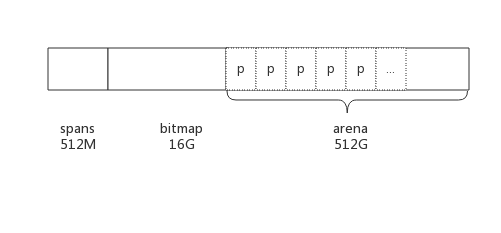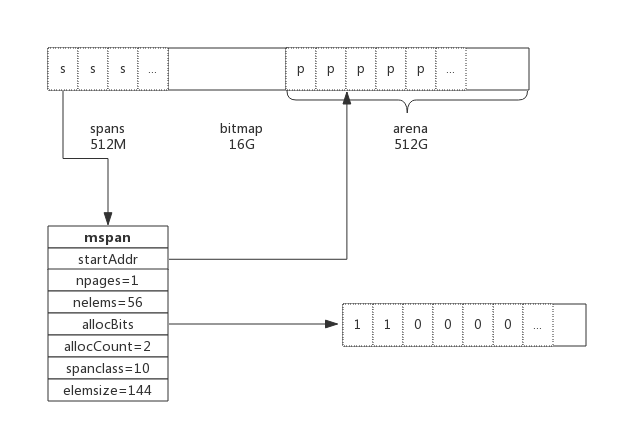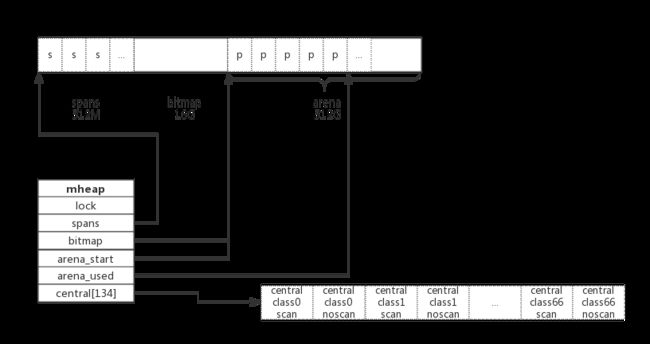Go语言——内存管理
参考:
图解 TCMalloc
Golang 内存管理
Go 内存管理
问题
- 内存碎片:避免内存碎片,提高内存利用率。
- 多线程:稳定性,效率问题。
内存分配
- arena即为所谓的堆区,应用中需要的内存从这里分配, 大小为512G,为了方便管理把arena区域划分成一个个的page,每个page为8KB,一共有512GB/8KB个页
- spans区域存放span的指针,每个指针对应一个page,所以span区域的大小为
(512GB/8KB) * 指针大小8byte = 512M - bitmap区域大小也是通过arena计算出来
512GB / (指针大小(8 byte) * 8 / 2) = 16G,用于表示arena区域中哪些地址保存了对象, 并且对象中哪些地址包含了指针,主要用于GC。
分配细节
- object size > 32K,则使用 mheap 直接分配。
- object size < 16 byte,不包含指针使用 mcache 的小对象分配器 tiny 直接分配;包含指针分配策略与[16 B, 32 K]类似。
- object size >= 16 byte && size <=32K byte 时,先使用 mcache 中对应的 size class 分配。
- 如果 mcache 对应的 size class 的 span 已经没有可用的块,则向 mcentral 请求。
- 如果 mcentral 也没有可用的块,则向 mheap 申请,并切分。
- 如果 mheap 也没有合适的 span,则向操作系统申请。
span
可以看出span是一个非常重要的数据结构,每个span包含若干个连续的page。
小对象分配会在span page中划分更小的粒度;大对象通过多页实现。
size class
go1.10\src\runtime\sizeclasses.go
// class bytes/obj bytes/span objects tail waste max waste
// 1 8 8192 1024 0 87.50%
// 2 16 8192 512 0 43.75%
// 3 32 8192 256 0 46.88%
// 4 48 8192 170 32 31.52%
// 5 64 8192 128 0 23.44%
// 6 80 8192 102 32 19.07%
// 7 96 8192 85 32 15.95%
// 8 112 8192 73 16 13.56%
// 9 128 8192 64 0 11.72%
// 10 144 8192 56 128 11.82%
// ...
// 65 28672 57344 2 0 4.91%
// 66 32768 32768 1 0 12.50%
上表中每列含义如下:
- class: class ID,每个span结构中都有一个class ID, 表示该span可处理的对象类型
- bytes/obj:该class代表对象的字节数
- bytes/span:每个span占用堆的字节数,也即页数*页大小
- objects: 每个span可分配的对象个数,也即(bytes/spans)/(bytes/obj)
- tail bytes: 每个span产生的内存碎片,也即(bytes/spans)%(bytes/obj)
上表可见最大的对象是32K大小,超过32K大小的由特殊的class表示,该class ID为0,每个class只包含一个对象。所以上面只有列出了1-66。
有点像装箱算法,按照规格分配,减少内存碎片。
struct
span是内存管理的基本单位,每个span用来管子特定的size class对象,根据size class,span将若干个页分成块进行管理。
go1.10\src\runtime\mheap.go
type mspan struct {
next *mspan // next span in list, or nil if none
prev *mspan // previous span in list, or nil if none
startAddr uintptr // address of first byte of span aka s.base()
npages uintptr // number of pages in span
nelems uintptr // number of object in the span.
allocBits *gcBits
gcmarkBits *gcBits
allocCount uint16 // number of allocated objects
spanclass spanClass // size class and noscan (uint8)
elemsize uintptr // computed from sizeclass or from npages
}
以size class 10为例,npages=1,nelems=56,spanclass=10,elemsize=144;startAddr指arena区位置;next和prev指spans区,span链表;allocBits是一个bitmap,标记分配块分配情况,这个设计我也用过,之前用redis bitmap实现了IPAM。
cache
从上面我们知道go通过span来分配内存,那在哪里用span?通过之前的学习Go语言——goroutine并发模型,我们知道每个P都有mcache,通过mcache管理每个G需要的内存。
go1.10\src\runtime\mcache.go
type mcache struct {
tiny uintptr
tinyoffset uintptr
alloc [numSpanClasses]*mspan // spans to allocate from, indexed by spanClass
}
numSpanClasses = _NumSizeClasses << 1
_NumSizeClasses = 67
alloc是span数组,长度是67 << 1,说明每种size class有2组元素。第一组span对象中包含了指针,叫做scan,表示需要gc scan;第二组没有指针,叫做noscan。提高gc scan性能。
mcache初始没有span,G先从central动态申请span,并缓存在cache。
central
go1.10\src\runtime\mcentral.go
type mcentral struct {
lock mutex
spanclass spanClass
nonempty mSpanList // list of spans with a free object, ie a nonempty free list
empty mSpanList // list of spans with no free objects (or cached in an mcache)
// nmalloc is the cumulative count of objects allocated from
// this mcentral, assuming all spans in mcaches are
// fully-allocated. Written atomically, read under STW.
nmalloc uint64
}
- lock: 多个G并发从central申请span,所以需要lock,保证一致性
- spanclass : 每个mcentral管理着一组有相同size class的span列表
- nonempty: 指还有内存可用的span列表
- empty: 指没有内存可用的span列表
- nmalloc: 指累计分配的对象个数
线程从central获取span步骤如下:
- 加锁
- 从nonempty列表获取一个可用span,并将其从链表中删除
- 将取出的span放入empty链表
- 将span返回给线程
- 解锁
- 线程将该span缓存进cache
线程将span归还步骤如下:
- 加锁
- 将span从empty列表删除
- 将span加入nonempty列表
- 解锁
heap
central只管理特定的size class span,所以必然有一个更上层的数据结构,管理所有的sizeclass central,这就是heap。
go1.10\src\runtime\mheap.go
type mheap struct {
lock mutex
spans []*mspan
// Malloc stats.
largealloc uint64 // bytes allocated for large objects
nlargealloc uint64 // number of large object allocations
largefree uint64 // bytes freed for large objects (>maxsmallsize)
nlargefree uint64 // number of frees for large objects (>maxsmallsize)
// range of addresses we might see in the heap
bitmap uintptr // Points to one byte past the end of the bitmap
bitmap_mapped uintptr
arena_start uintptr
arena_used uintptr // Set with setArenaUsed.
arena_alloc uintptr
arena_end uintptr
arena_reserved bool
central [numSpanClasses]struct {
mcentral mcentral
pad [sys.CacheLineSize - unsafe.Sizeof(mcentral{})%sys.CacheLineSize]byte
}
}
- spans:映射span -> page
- large:大对象,>32K
- bitmap: gc
- arena: arena区相关信息,pages,堆区
- central:通过size class管理span,每种size class对应两个central
code
前面都是背景知识,现在开始具体的分配过程
go1.10\src\runtime\malloc.go
注释
小对象
- 申请
// Allocating a small object proceeds up a hierarchy of caches:
//
// 1. Round the size up to one of the small size classes
// and look in the corresponding mspan in this P's mcache.
// Scan the mspan's free bitmap to find a free slot.
// If there is a free slot, allocate it.
// This can all be done without acquiring a lock.
//
// 2. If the mspan has no free slots, obtain a new mspan
// from the mcentral's list of mspans of the required size
// class that have free space.
// Obtaining a whole span amortizes the cost of locking
// the mcentral.
//
// 3. If the mcentral's mspan list is empty, obtain a run
// of pages from the mheap to use for the mspan.
//
// 4. If the mheap is empty or has no page runs large enough,
// allocate a new group of pages (at least 1MB) from the
// operating system. Allocating a large run of pages
// amortizes the cost of talking to the operating system.
- 将申请的内存大小,向上取整成对应的size class;并且从P的mcache中找对应的mspan。
- 如果mspan有空闲slot,就分配。这个过程不需要lock,因为只有一个G会向P申请。
- 如果mspan没有空闲slot,就从mcentral获取新的mspan。这个过程需要lock,因为会有多个G同时申请。
- 如果mcentral没有mspan,就从mheap申请。
- 如果mheap空间不足,就想OS申请一组page,最少1MB。
- 释放
// Sweeping an mspan and freeing objects on it proceeds up a similar
// hierarchy:
//
// 1. If the mspan is being swept in response to allocation, it
// is returned to the mcache to satisfy the allocation.
//
// 2. Otherwise, if the mspan still has allocated objects in it,
// it is placed on the mcentral free list for the mspan's size
// class.
//
// 3. Otherwise, if all objects in the mspan are free, the mspan
// is now "idle", so it is returned to the mheap and no longer
// has a size class.
// This may coalesce it with adjacent idle mspans.
//
// 4. If an mspan remains idle for long enough, return its pages
// to the operating system.
- 如果mspan在响应分配时被扫描,就返回mcache以满足分配。(不是很理解)
- 如果mspan中有分配的对象,就将它放置到mcentral的free list中
- 如果mspan空闲,就返回mheap,并且不关联size class,即变成page
- 如果msapn空闲很久,就把page还给OS,缩容。
大对象
// Allocating and freeing a large object uses the mheap
// directly, bypassing the mcache and mcentral.
大对象都是直接操作mheap,跳过mcache和mcentral
实现
tiny( < 16 byte )
off := c.tinyoffset
// Align tiny pointer for required (conservative) alignment.
if size&7 == 0 {
off = round(off, 8)
} else if size&3 == 0 {
off = round(off, 4)
} else if size&1 == 0 {
off = round(off, 2)
}
if off+size <= maxTinySize && c.tiny != 0 {
// The object fits into existing tiny block.
x = unsafe.Pointer(c.tiny + off)
c.tinyoffset = off + size
c.local_tinyallocs++
mp.mallocing = 0
releasem(mp)
return x
}
// Allocate a new maxTinySize block.
span := c.alloc[tinySpanClass]
v := nextFreeFast(span)
if v == 0 {
v, _, shouldhelpgc = c.nextFree(tinySpanClass)
}
x = unsafe.Pointer(v)
(*[2]uint64)(x)[0] = 0
(*[2]uint64)(x)[1] = 0
// See if we need to replace the existing tiny block with the new one
// based on amount of remaining free space.
if size < c.tinyoffset || c.tiny == 0 {
c.tiny = uintptr(x)
c.tinyoffset = size
}
size = maxTinySize
tinyoffset表示tiny当前分配到什么地址了,之后的分配根据 tinyoffset 寻址。
- 先根据要分配的对象大小进行地址对齐,比如size是8的倍数,tinyoffset 和 8 对齐。
- 然后就是进行分配。如果tiny剩余的空间不够用,则重新申请一个 16 byte 的内存块,并分配给 object。
- 如果新块剩余空间比老快大,就用新的内存块替换。
large(> 32 k)
var s *mspan
shouldhelpgc = true
systemstack(func() {
s = largeAlloc(size, needzero, noscan)
})
s.freeindex = 1
s.allocCount = 1
x = unsafe.Pointer(s.base())
size = s.elemsize
func largeAlloc(size uintptr, needzero bool, noscan bool) *mspan {
if size+_PageSize < size {
throw("out of memory")
}
npages := size >> _PageShift
if size&_PageMask != 0 {
npages++
}
// Deduct credit for this span allocation and sweep if
// necessary. mHeap_Alloc will also sweep npages, so this only
// pays the debt down to npage pages.
deductSweepCredit(npages*_PageSize, npages)
s := mheap_.alloc(npages, makeSpanClass(0, noscan), true, needzero)
if s == nil {
throw("out of memory")
}
s.limit = s.base() + size
heapBitsForSpan(s.base()).initSpan(s)
return s
}
跳过了mspan和mcentral,直接在mheap上面分配。
normal([16 b, 32 k])
var sizeclass uint8
if size <= smallSizeMax-8 {
sizeclass = size_to_class8[(size+smallSizeDiv-1)/smallSizeDiv]
} else {
sizeclass = size_to_class128[(size-smallSizeMax+largeSizeDiv-1)/largeSizeDiv]
}
size = uintptr(class_to_size[sizeclass])
spc := makeSpanClass(sizeclass, noscan)
span := c.alloc[spc]
v := nextFreeFast(span)
if v == 0 {
v, span, shouldhelpgc = c.nextFree(spc)
}
x = unsafe.Pointer(v)
if needzero && span.needzero != 0 {
memclrNoHeapPointers(unsafe.Pointer(v), size)
}
对于 size 介于 16 ~ 32K byte 的内存分配
- 先计算应该分配的 sizeclass,
- 然后去 mcache 里面 alloc[sizeclass] 申请,
- 如果 mcache.alloc[sizeclass] 不足以申请,则 mcache 向 mcentral 申请,然后再分配。
- mcentral 给 mcache 分配完之后会判断自己需不需要扩充,如果需要则向 mheap 申请。
计算出 sizeclass,那么就可以去 mcache.alloc[sizeclass] 分配了,注意这是一个 mspan 指针,真正的分配函数是 nextFreeFast() 函数:
// nextFreeFast returns the next free object if one is quickly available.
// Otherwise it returns 0.
func nextFreeFast(s *mspan) gclinkptr {
theBit := sys.Ctz64(s.allocCache) // Is there a free object in the allocCache?
if theBit < 64 {
result := s.freeindex + uintptr(theBit)
if result < s.nelems {
freeidx := result + 1
if freeidx%64 == 0 && freeidx != s.nelems {
return 0
}
s.allocCache >>= uint(theBit + 1)
s.freeindex = freeidx
s.allocCount++
return gclinkptr(result*s.elemsize + s.base())
}
}
return 0
}
allocCache 这里是用位图表示内存是否可用,1 表示可用。然后通过 span 里面的 freeindex 和 elemsize 来计算地址即可。
当mcache没有可用地址时,通过nextFree向mcentral甚至mheap申请:
func (c *mcache) nextFree(spc spanClass) (v gclinkptr, s *mspan, shouldhelpgc bool) {
s = c.alloc[spc]
shouldhelpgc = false
freeIndex := s.nextFreeIndex()
if freeIndex == s.nelems {
systemstack(func() {
c.refill(spc)
})
shouldhelpgc = true
s = c.alloc[spc]
freeIndex = s.nextFreeIndex()
}
if freeIndex >= s.nelems {
throw("freeIndex is not valid")
}
v = gclinkptr(freeIndex*s.elemsize + s.base())
s.allocCount++
return
}
mcache 向 mcentral,如果 mcentral 不够,则向 mheap 申请。
// Gets a span that has a free object in it and assigns it
// to be the cached span for the given sizeclass. Returns this span.
func (c *mcache) refill(spc spanClass) {
_g_ := getg()
_g_.m.locks++
// Return the current cached span to the central lists.
s := c.alloc[spc]
// Get a new cached span from the central lists.
s = mheap_.central[spc].mcentral.cacheSpan()
c.alloc[spc] = s
_g_.m.locks--
}


